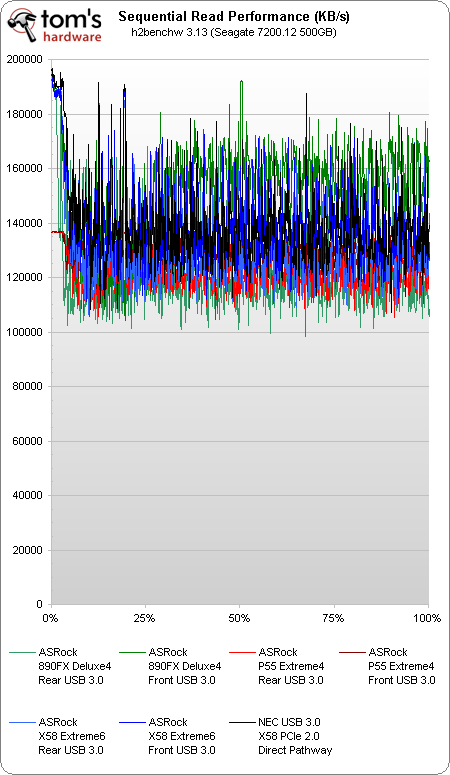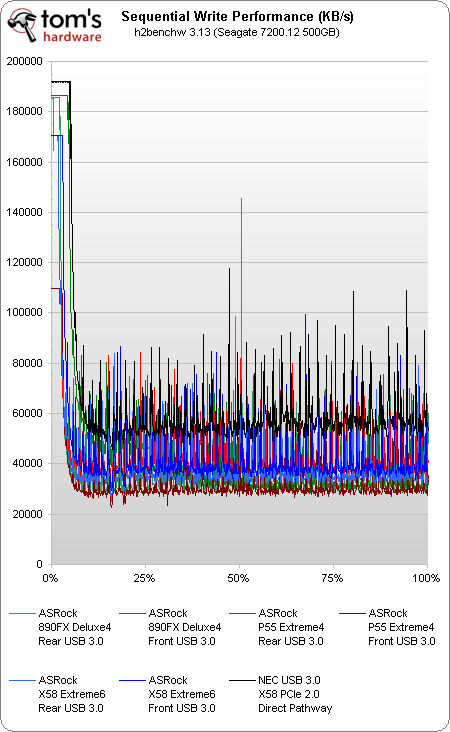USB 3.0 To The Front Panel: ASRock Leads The Way
ASRock was the first company to respond to our impassioned pleas for a front-panel USB 3.0 connector. As other companies attempt to catch up, we examine the boards that started it all to see if the implementation maintains full USB 3.0-class performance.
Sequential Transfer Graphs
The most difficult part of testing ASRock’s front-panel USB 3.0 implementation has little to do with the interface, but is instead caused by our drives. After a few days of testing, our fastest test drive failed. After a couple more days of testing, our second-fastest drive suddenly slowed compared to previous runs. While we know that writing all the cells on an SSD slows its performance (due to the need to erase before rewriting), it puzzles us that the drive would behave well through a dozen complete overwrites, and then slow down. The performance after the slowdown was consistent however, so we pressed on by retesting all configurations yet again.
ASRock’s 890FX motherboard gets nearly the same performance as our X58 reference build, while ASRock’s X58/PCIe bridge pathway falls only slightly behind. The best news is that front-panel performance mirrors rear-panel performance, proving the effectiveness of the ASRock/Intel front-panel port design.
Repeat what we said about read performance for writes, though the write transfer charts make it easier to see how ASRock’s P55 solution falls behind.
Get Tom's Hardware's best news and in-depth reviews, straight to your inbox.
Current page: Sequential Transfer Graphs
Prev Page Test Settings Next Page Sustained And Repetitive Transfer Performance-
Thank you ASRock for bringing USB3.0 front header on your motherboards! Now i can expect a much nicer set-up in my case in an upcoming build...Reply
-
Crashman razor512Now all they need to do is lead the way with a standardized case connector.darthvidorI sure hope the standard connector comes out before this gets out of hand.You're looking at it, Page 1 photo. Other motherboard manufacturers are already using this same connector as mentioned in the article, so it should only be a matter of a few months before case manufacturers follow suit.Reply -
ASRock responds to pleas? Maybe someone could plead for dual-gigabit-ethernet equipped SOC-chipped (atom? i3?) 6x sata2 motherboards, too. It's impossible to build your one-machine-to-rule them all firewall-server-htpc in a small form factor currently!Reply
-
liquidsnake718 Yeah i remember reading reports that Intel dithed USB 3.0 about 6 months ago in favor of the mb and new CPU research (P66, 67). Surprisingly they sold this tech or the design to ASROCK. Im sure they will eventually come around to implimenting this for ALL future motherboards.Reply
So would old cases be able to use this since it is just a connector?
-
Crashman liquidsnake718Yeah i remember reading reports that Intel dithed USB 3.0 about 6 months ago in favor of the mb and new CPU research (P66, 67). Surprisingly they sold this tech or the design to ASROCK. Im sure they will eventually come around to implimenting this for ALL future motherboards. So would old cases be able to use this since it is just a connector?Revised cases could use it, if they had the new cable and connector. Remember that USB 2.0 and USB 3.0 are not cross-compatible, they use separate signal pins and share only power and ground with each other.Reply -
mauller07 They should have kept the board like the 890gx extreme 3 without all the legacy rubbish like floppy or pata, when looking at the boar layouts in comparison this extreme 4 just looks messyReply


